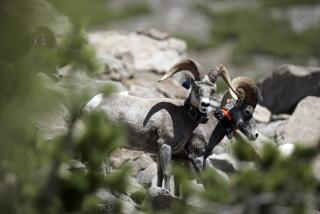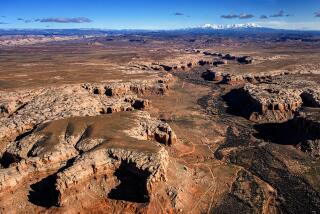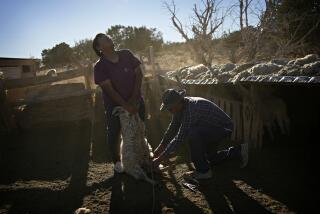Pure Bison Herd to Get Much-Needed Infusion
- Share via
CAPROCK CANYONS STATE PARK, Texas — The rumble from stampeding bison used to shake the earth as thousands of the majestic animals thundered across these parts centuries ago.
That sound has faded almost entirely now, and the fate of one of the last pure herds in North America -- begun by famous cattleman Charles Goodnight -- rests with a trio of bulls donated by media tycoon and bison rancher Ted Turner.
The Texas herd, once 250 strong, has dwindled to 53, and more than a century of inbreeding threatens its survival. The herd’s average age has increased by three years -- bison typically live between 12 to 15 years -- and the number of calves has dropped in recent years. Nine were born last year.
With Turner’s bulls, the Texas Parks and Wildlife Department and Texas A&M; University’s College of Veterinary Medicine hope to strengthen the herd and preserve an animal that symbolizes the American West.
“We don’t know exactly what the outcome will be,” said James Derr, an associate professor of veterinary pathobiology at Texas A&M.; “We do know the outcome if we do nothing. This herd will become extinct.”
The Texas herd was started in the 1870s with five bison calves captured by Goodnight, one of the most prosperous cattlemen in the West, with more than 1 million acres of ranchland and 100,000 head of cattle at his peak.
His wife, Mary Ann, urged him to save the bison because hunters were killing them by the hundreds of thousands for their hides and meat, and to crush American Indian tribes who depended on the animals for food and clothing.
The herd was donated to the state in 1997 and moved to 330 acres of Caprock Canyons State Park, which was once part of Goodnight’s JA Ranch between Lubbock and Amarillo.
While doing pregnancy tests on the herd in fall 2001, researchers found that 15 of the 18 adult females were pregnant. However, by spring, when the females were due, only five calves survived. The rest were either not born or did not survive long after birth.
Disease and genetic problems, such as chromosomal defects, were ruled out. As part of another project, Derr and another researcher already were sampling the DNA from the federal bison herds throughout the United States. They knew how much genetic variation there should be in an “average” bison, and they found the Texas herd “had significantly less genetic variation” than any of the federal herds and most of the state and private herds, Derr said.
Researchers concluded the herd suffered from inbreeding depression. Since the herd was confined on the Goodnight ranch and then the state park, no new genes had entered the herd in 120 years. A computer model showed the herd would probably die out in 50 years if nothing was done to diversify the gene pool.
Still, researchers were reluctant to tamper with the herd too much, Derr said.
Since the herd originated in the Texas Panhandle, it is probably the last genetic example of what was called the Southern Plains bison, said Danny Swepston, a state wildlife district leader who oversees the herd.
When the Transcontinental Railroad was built across the U.S. in the 1800s, the bison -- which are believed to have numbered in the tens of millions -- were split into what was known as the Northern and the Southern herds. The Southern herds were made up of animals from Texas, eastern New Mexico, eastern Colorado, Kansas, Oklahoma and southern Nebraska.
Derr said the best option was to try to find a herd with a historical link to the Texas bison and a lot of genetic variation, but not hybrids of cattle and bison or animals infected with contagious diseases.
They found their link with Turner’s herd in New Mexico. So in 2003, wildlife representatives, along with Texas A&M; researchers, traveled across the Texas-New Mexico border and chose three 1 1/2 -year-old bulls.
Turner owns the largest private bison herd in the world with about 40,000 head on 13 ranches in seven states. He is interested in rebuilding the country’s bison population, which currently is about 250,000. He also raises bison to supply meat at his Ted’s Montana Grill restaurant chain.
“We obviously are committed to the conservation of bison as a keystone species,” said Russ Miller, general manager of Turner Enterprises, which oversees Turner’s herd. “We were glad to be contributing partners to the effort.”
In June, one of the Turner bulls will breed with as many as five females, Derr said. The females will be kept in an area separate from the rest of the Texas herd, which will continue its regular breeding cycle.
Researchers will check the calves’ DNA in December 2006 to gauge the amount of genetic variation brought to the Texas herd, then use the other two bulls for breeding over the next two years. It will take about seven years to see if the experiment is a success, Derr said.
Pat Bierschwale, president of the Texas Bison Assn., said the project was just the latest step in a preservation effort started more than 130 years ago by Goodnight.
“What’s the alternative if the herd is destined to be extinct?” he said. “Are we doing any less than Mr. Goodnight did by trying to save them?”
More to Read
Sign up for Essential California
The most important California stories and recommendations in your inbox every morning.
You may occasionally receive promotional content from the Los Angeles Times.










